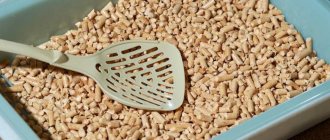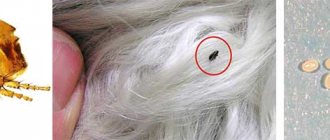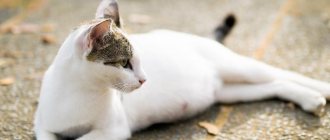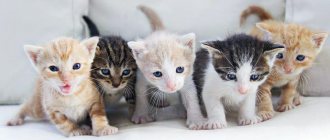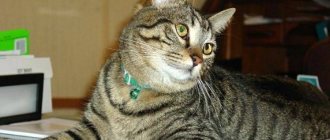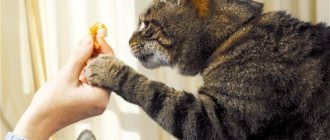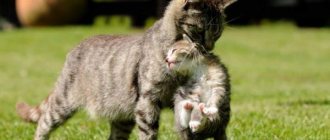If a cat cannot pee, this is a likely symptom of urolithiasis, cystitis, traumatic injury to the bladder or spinal cord, or dehydration. There is a depressed state of the pet, lethargy, loss of appetite, and pale mucous membranes. The owner must know how to help the pet before visiting the veterinary clinic. The veterinarian will conduct a diagnosis, prescribe treatment and diet, and give preventive recommendations.
According to statistics from veterinarians, urolithiasis in cats is diagnosed in 13% of cases, mainly in young animals.
Why can't a cat urinate?
It is considered normal if an adult cat goes to the litter box 2-3 times a day. per day, in the heat he urinates less often, and when it is cold - more often, but no more than 5 times. A breastfed kitten hardly walks and may not pee until 2 p.m. at 7 days, since food is immediately absorbed and the baby’s body produces little urine. After 3 months, the baby visits the tray at least 2 times. The condition is alarming if the cat has not peed for 2 days in the absence of significant diseases, proper diet and sufficient water.
Urolithiasis
Animals that are often fed fish suffer from this disease.
Difficulty urinating is caused by urolithiasis, in which the ureters become clogged with salt deposits and sand accumulates in the bladder. The cause of the condition is a lack of fluid intake, improperly selected food, a predominantly meat or fish diet, kidney disease, due to which urine is excreted unstable, becomes concentrated and struvite and oxalates are formed in it. The cat cannot go to the toilet for two or three days, and the scanty discharge contains blood.
Cystitis
A cat cannot pee for more than a day due to inflammatory processes in the bladder. Cystitis is infectious when the disease is provoked by bacteria and viruses. Most often, the cause is hypothermia and decreased immunity, against the background of which the pathogenic microflora of the urinary tract is activated. Non-infectious idiopathic cystitis is also known, the etiology of which is unknown and often develops due to stress, disruption of the central nervous system and endocrine system.
Traumatic injuries
If an animal falls from a height, it can suffer serious injuries that will interfere with normal bladder emptying.
Acute urinary retention, when a cat does not go to the toilet for several days, can be caused by a bladder injury. This occurs as a result of a fall from a height, a car injury, or fights with relatives. Injury to the back and spinal cord is also a factor in the rare urge to urinate. The innervation of the pelvic organs and hind limbs is disrupted, which leads to organ dysfunction. In this case, urine comes out drop by drop, and bloody impurities are present.
Dehydration
No urine is produced if the cat drinks little or no fluids. The reasons are varied - frequent vomiting or diarrhea, diabetes, heavy bleeding, infectious diseases, heat or sunstroke, lack of water in everyday life. Problems with urination can occur in cats without fur - Sphynx, Bambino, Levkoy, since representatives of these breeds drink very little.
Reasons for deviations from the norm
Deviation of the frequency of urination from the norm can be due to both external conditions and physiological factors, and pathological reasons.
Physiological (diet, external conditions)
Cats are emotional creatures, so they react acutely to changes happening around them. A move, a change in diet, the owner's departure, a trip to the clinic, the appearance of a child or another animal in the house, and other stressful situations can cause a cat to visit the litter box more often or less often than usual. This is due to a reflex contraction of the bladder muscles against the background of psycho-emotional stress. Stress is also indicated by increased licking, changes in appetite, and atypical behavior. Restoration of urinary function usually occurs within 3 days.
Alarming symptoms when you need to see a doctor
When a cat does not pee for one day, you should carefully monitor it, especially if your pet is old and has chronic illnesses. The following symptoms require an urgent trip to the veterinarian:
The problem in the animal can be complemented by a state of anxiety.
- The animal sits on the potty and does not urinate for a long time.
- Urine does not pass for several hours when trying to pee, it comes out in drops.
- Blood impurities.
- The cat cannot get up and pees under itself, meowing in pain.
- Anxiety.
- Lack of appetite and sleep.
- Temperature increase.
- Tight, painful and bloated abdomen.
- Breathing disorders due to intoxication of the body with urine products.
Safe deviations from normal values
In some cases, male cats may exhibit deviations from the norm in the number of urinations per day.
A cat may not pee for several reasons; deviations in consequence do not pose a danger:
- changes in climate, place of residence, owner;
- dramatic changes in diet;
- stress;
- castration or sterilization.
After the animal adapts to new conditions, the urination pattern returns to normal. It takes 2-3 days for your pet to recover from castration. Cats take longer to recover after sterilization - in the first days they walk “little by little” through a catheter.
What to do if the cat stops writing?
Warming compress
When a pet sits in a litter tray for a long time and does not pee, this is a reason to urgently show it to the veterinarian, since a catheter is required, after which the cat will urinate. A dry, warm compress will help your cat relieve pain if infrequent urination is not accompanied by infectious inflammation. A bag of heated salt or sand is suitable, which is placed on the stomach between the hind legs. First aid should not include massage or stroking, as this strains the bladder, dislodges stones and worsens the condition.
Herbal infusion
You can try to alleviate the animal's condition with lingonberry decoction.
At home, you can prepare and give a herbal decoction of plantain, lingonberry or rosehip, which is gradually poured through a syringe without a needle. If the cat has not peed for a whole day or more, or the belly is swollen due to accumulated urine, the amount of drinking should be kept to a minimum. You should also force the kitten to drink if it is older than 3 months and does not pee well. Preparation:
- Take 5 g of any plant, pour 200 ml of hot water.
- Infuse, cool, filter, dilute a little with water.
- Pour in 5-7 ml at intervals so that the animal has time to swallow.
How many times a day should a cat pee?
The number of urinations per day depends on gender, age, physiological state, living conditions and diet. For kittens and adults, everything is different: diet, food consistency, physical activity.
Young animals, as a rule, do not have chronic diseases, so there are no pathological factors affecting the consumption of feed, water and physiological functions.
Normal for kittens
Babies feed on milk for up to a month and are in the den with the cat, so the number of trips to the toilet remains unnoticed by the owner. In the period from 1 to 3 months, the number of trips is 1-3 times a day. But this is on average. The playful kitten drinks a lot and, accordingly, pees a lot. The norm for a kitten from 3 to 6 months is considered to be from 2 to 6 urinations per day.
Normal for adult pets
Kittens switch to the adult type of feeding, drinking and fulfilling physiological needs after reaching six months. By this time, gender begins to play a role in the number of urinations. In cats, the path from the bladder to the external environment is straight, in males it is tortuous. Therefore, the female urinates rarely - 1-2 times a day, and the cat often - from 4 to 6 times.
Pregnancy increases the frequency of trips to the litter box. Castration, on the contrary, reduces it. Pets can make no more than one trip per day. Older cats behave in a similar way. Animals over 8 years old become couch potatoes and do not go to the toilet every day. If your pet looks neat and does not meow pitifully when visiting the litter box, you should not worry.
How to treat a cat that doesn't pee well?
If the cat urinates rarely and drop by drop, it is necessary to install a catheter, which promotes the outflow of urine and emptying of the bladder. The procedure is painful, so it is often performed under anesthesia. After catheterization, the animal walks with a tube for 2-3 days. During this period, the cat is given antibiotics to prevent inflammation. The tube cannot be installed permanently; this leads to swelling of the bladder. After removing the catheter, the urethral cavity is washed with an antiseptic. When a cat does not pee due to urolithiasis, surgery is performed to remove the stones. If it is painful for a cat to pee due to cystitis, antispasmodics, painkillers and sedatives are prescribed. In case of injury, surgery is necessary.
Therapeutic diet
For animals with urinary problems, there is a special food from the Royal Canin line.
If the cat pees little, sits in the tray and urine drips little by little, he needs a special diet. If there is a lack of fluid, it is recommended to make lean chicken broth and mix it with wet food. Poor urination should be treated with foods with the Urinary symbol - Royal Canin, Fest Choice, Proplan, Bosch Sanabel, which contain taurine. Raw meat and fish, dairy products, salted, smoked and fatty foods are prohibited. In combination with quality products, lean boiled meat and fish fillets, boiled or stewed vegetables, and cranberry broth are recommended.
Normal urination indicators
In domestic cats and cats, urine production in an amount of 50 to 200 ml is considered normal. These indicators may vary depending on :
- Age . A newborn kitten does not pee at all during the first week, since the mother constantly licks it; later, urination once a day is considered normal. As they grow older, the frequency of trips to the toilet increases and by the age of three months cats should pee up to 3 times a day. A six-month-old kitten runs around to relieve itself from 6 to 10 times a day. Adult, mature animals drink less, and therefore the frequency of urination is reduced on average to 5 times and the norm is to urinate from two to six times a day.
- Activities . Very lazy, sedentary pets pee once a day, active and playful ones tend to drink more, which means they can do “little things” more often.
- Paula . Cats go to the toilet more often than cats. This is explained by the special structure of the genitourinary system, the channels of which are narrow and curved, which inhibits the outflow of urine and causes more frequent trips to the tray. Due to this structure, cats are more susceptible to urolithiasis than females. Cats, including sterilized ones, normally pee 1-3 times a day, males - 3-6 times with normal nutrition.
- Feeding _ The cat's diet is of great importance. When feeding dry food, it is necessary to provide the animal with continuous access to fresh water (it is better if it is filtered). In some cases, the animal's frequent visits to the tray are caused by overeating dry food, which results in drinking plenty of water. Accordingly, the cat will often go to the toilet, but you need to make sure that there is no blood in the urine.
Neutered animals are most susceptible to developing diseases of the urinary system. For this reason, the urination of such an animal must be monitored especially carefully. A castrated cat should pee 2-3 times a day, but much depends on feeding, character and age of the pet.
Prevention
Playing active games with your pet will help you avoid bladder problems, since obesity causes your cat to sit on the tray and not urinate. The cat should be protected from hypothermia. And in hot weather, you need to use a cooling mat so that your pet does not lie on the floor. Food should be purchased from holistic or premium brands that contain natural ingredients. It is forbidden to physically punish a pet if it has peed in the wrong place - this may be the beginning of a disease, and beatings will accelerate the inflammatory process.
What are the reasons for deviations from the norm?
A distinction is made between pollakiuria—frequent urination and oliguria—decreased urine volume with infrequent visits to the litter box.
Pollakiuria develops for the following reasons:
- Aging : The sphincter of the bladder relaxes and urine flows to the outlet valve of the urethra. The pet squats all the time, trying to defecate,
- Cystitis : inflammation of the bladder accompanied by frequent and painful urination.
- Inflammation of the prostate: mainly affects older pets.
- Stress : fright, the appearance of a new pet in the apartment, the appearance of the owner after a long absence.
- Pathological conditions that cause thirst - poisoning, infectious or non-communicable diseases are accompanied by an increase in trips to the litter box.
Oliguria is associated with dehydration, which occurs with prolonged vomiting and diarrhea, or urolithiasis, when a complete cessation of urination is possible. This condition is called anuria, it threatens the life of the animal and requires emergency veterinary care.
Why is this happening
There may be several reasons for the development of this condition:
- Acute intestinal obstruction. May develop as a result of obstruction by a foreign body (hairball, swallowed bag or cord), intussusception.
- Tumor in the large intestine. The tumor can compress the intestinal lumen and prevent the passage of feces.
- Inflammatory bowel diseases.
- Pathology of the anus. Mechanical damage to the sphincter, such as scar deformity, can make bowel movements difficult.
- Dietary disorder. Insufficient fiber and water intake, and dry food can lead to excessive dryness of stool, which makes it difficult to pass.
Something else interesting: Diagnosis and principles of treatment of viral peritonitis in cats
How to recognize difficulties
In order to recognize the pathology, it is enough to carefully monitor your pet:
- The cat goes to the toilet less than once every 2 days.
- During the act of defecation she experiences pain.
- An admixture of blood, pus or mucus is detected in the feces.
Animal treatment
You can help your pet only after discovering the cause. If the cause is scar deformity, tumor or intussusception, surgical intervention is necessary. If the condition is caused by poor nutrition, you need to reconsider your diet and add more fluid. For inflammatory diseases, antibiotics are prescribed. Symptomatic treatment is the prescription of laxatives, but these drugs can only be used after consulting a veterinarian.
